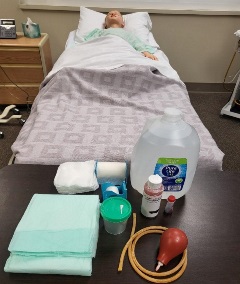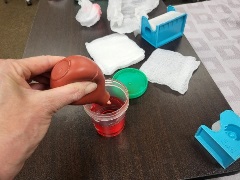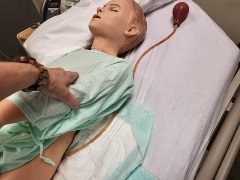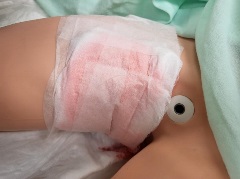HomeGrown Solution: Post- Heart Catheterization Site Bleed
Title
Post- Heart Catheterization Site Bleed
Submitted By
HomeGrown Solution Number
Identification of the Problem
Recognition of complications, such as arterial bleeding at the post-insertion site following heart catheterization, are vital assessment findings requiring immediate interventions. Low- and many high-fidelity manikins have no functionality when it comes to portraying this major complication. To enhance fidelity and realism, a solution has been created to portray early recognition and implementation of interventions associated with this life-threatening complication.
Unique Idea
This low-cost, realistic solution was developed out of the faculty’s concern that learners were not recognizing life-threatening post-heart catheterization complications in the pediatric population. Lack of recognition thus hinders early life-saving interventions. After the simulation scenario was built out, then came brainstorming on how to create a solution for a post-catheterization site to go from dry to bloody. When thinking about the supplies that it would take to make this solution work and look realistic, it was then determined we had all the supplies needed readily available in our lab. It was then that this post-heart catheterization bleeder became a reality, and learners began recognizing a major complication requiring immediate interventions. We hope to think lives have been saved!
Objectives
Learner Objectives:
- Design a low-cost, realistic solution to enhance realism in a patient experiencing a post-catheterization bleed.
- Design a low-cost, realistic solution to enhance early recognition of a patient experiencing a post-catheterization bleed.
- Design a low-cost, realistic solution to improve early implementation of care for a patient experiencing a life-threatening post-catheterization bleed.
Learning Outcomes:
- Learners will engage in a more realistic simulation to improve the identification of a post-catheterization bleed.
- Learners will engage in a more realistic simulation to improve their response to this life-threatening complication.
Supplies/Ingredients
- low- or high-fidelity patient simulator on a stretcher or in a hospital bed
- suction bulb (rubber or bulb syringe)
- manikin IV tubing (amount will depend on where your simulated participant will be located beside the patient when they push the bulb to bleed)
- specimen container with lid
- simulated blood ‘red’ coloring (food coloring or blood-colored concentrate purchased from a vendor)
- 4 x 4 dressings
- 3" and 1" paper tape or other dressing tape
- disposable underpads (blue pad or green pad)
- distilled or tap water
Steps to Creating the Solution
- After gathering the supplies, place the disposable underpads on the bed or stretcher under the manikin for the post-heart catheterization scenario.
- Pour distilled or tap water into the specimen cup, add the simulated blood to the liquid, replace the lid, swirl, and then place the blood mixture to the side.
- Place a 4 x 4 on the manikin’s groin (femoral) area (left or right side will depend on your scenario) then tape one end of the IV tubing on the top middle portion of the 4 x 4 and secure it with 1" tape.
- Place several more layers of 4 x 4’s on top of the bottom 4 x 4 with the taped IV tube. Secure all to the manikin with the 3" tape.
- Run the IV tube under the manikin’s leg, back, etc. to where you want the tube/bulb to be hidden.
- Fill the bulb syringe with simulated blood by squeezing the bulb and placing it in the solutions. Once filled, release the bulb. Attach the end of the bulb filled with solution to the other end of the IV tubing.
- Place the prefilled bulb syringe and tubing where you want to hide it so the learners don’t see it, but your simulated family member knows where it is located. (It can be beside the manikin, by the head of the manikin, under the pillow, etc. as long as it is hidden from the site. Normally I locate it on the opposite side of the heart catheterization insertion site.)
- When the manikin states they are nauseated and then ‘vomits.’ At that point, the SP squeezes the bulb causing the dressing to become saturated with simulated blood at the heart catheterization insertion site. (Then per your scenario, the vital signs can drop to correspond with an arterial bleed to alert the learner to hold pressure at the heart catheterization insertion site and call for help.)
- Following the simulation, remove the dressing and clean up the site or reapply fresh 4 x 4 dressing and set up the scenario for the next learner.
Images
Video
<HomeGrown Disclaimer
The information contained within this website is for information purposes only. While the website is monitored in an attempt to keep the information up to date and accurate, be aware that there are no representations or warranties of any kind, express or implied, about the completeness, accuracy, reliability, and/or suitability being made. The sponsors of this website are not liable for any loss or damage that may result from using information contained within this website. Any reliance you place on the information contained within this website is strictly at your own risk.
Please note that sections of this website include postings of individuals not associated with the website sponsors. These postings are not endorsed or warrantied by the website, and use of such information is at your own risk.
Always check the user guide/manuals provided by the manufacturer of your manikin or task trainer. Using products that are not sanctioned may invalidate the product warranty. (For example: Some products could stain the skin on a manikin. Liquids used around electrical parts may cause malfunctions.)






